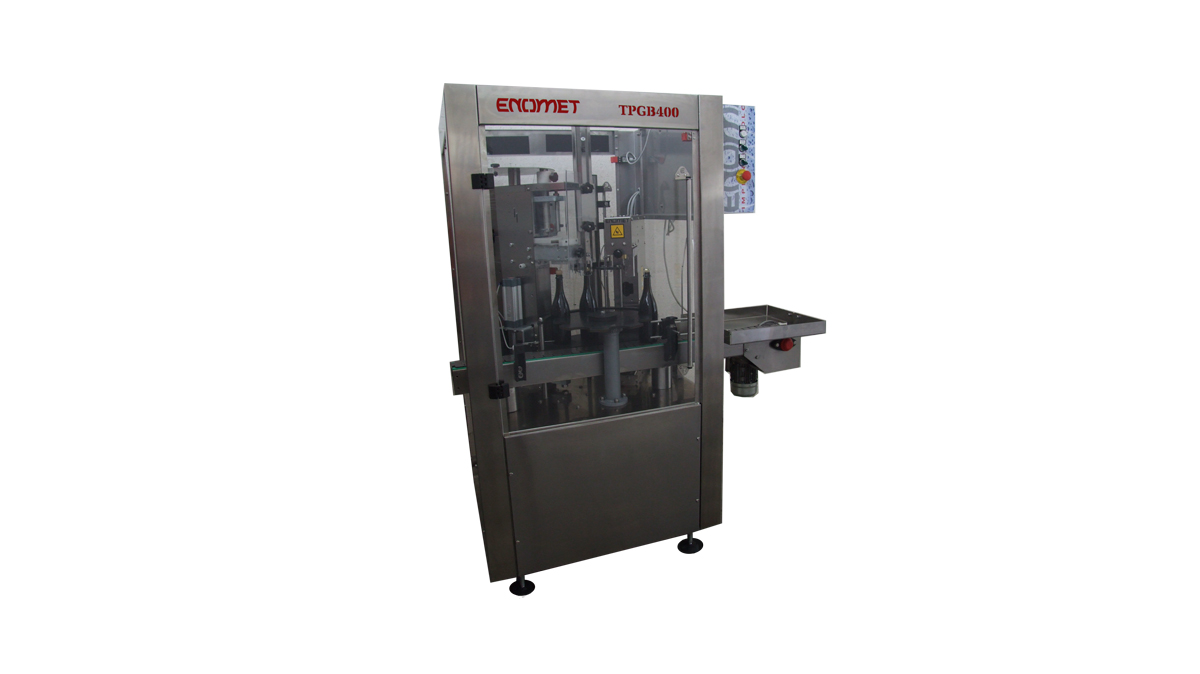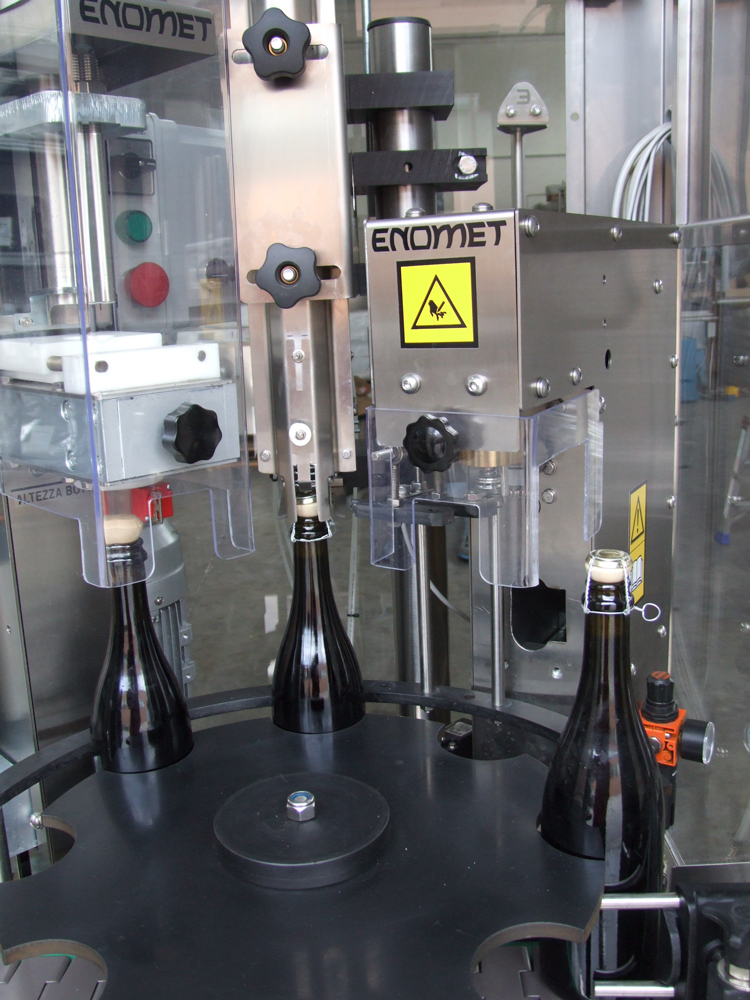Winegrowers Supplies
- Automatic Isobaric (counter-pressure) bottle fillers, with corkers and wire muzzlers, or crown cappers (for beer) or ROPP cappers
A counter-pressure filler is necessary for bottling already carbonated drinks, such as beer, Sparkling cider or wine.
If the drink is already stored under pressure, it can flow directly to an isobaric filler, there is no need for a pump.
Alternatively, carbonation can be carried out automatically in the filling line.
To avoid excess foaming the temperature of the liquid (when inside the filler's header tank) should be between - 3 °C and + 4 °C; ideally 2 °C.
If there are problems with foam in the filler or after filling (between filler and corker) it depends on different factors:-
Cooling down the drink (to a temperature around 2 °C) before filling is more important for the foaming aspect than the type of valve used for filling.
At 2 °C there will be good impregnation of the gas when inside the carbonator, afterwards the drink will be more stable during the filling process.
The amount of sugar in the drink and the fineness of it's filtration have a big influence on the stability.
Gases other than CO2 already present in the drink have a detrimental affect.

EN monobloc EDO 6 ISO R TPGB: automatic bottle filler with corker and wire muzzler, 39,295 Euros



An in-line version of the EDO 6 ISO R isobaric filler, combined with the TPGB 400 corker and wire muzzler.
Throughput of 300 to 500 bottles/hour.
There is a station for injection of inert gas into the bottle before the filling. Any type of inert gas can be used; usually it's Nitrogen.
The quantity of gas is adjustable easily and quickly. It’s really only needed for still wines, so it's possible to activate or to disarm this station.
Compressed air: max 6 bar. Consumption of air: max 10.4 Nls.
Three-phase 380 Volts, 1.5 kWatt. 910 x 1700 x 2050 mmH. Weighs 580 Kilos.
Options:-
Additional bottle formats.
Driving table for loading and collecting table for finished bottles, 1285 Euros.
Hopper to distribute normal corks.
Semi-automatic feeder for mushroom corks.

Careddu Gold:-
These are 'very heavy duty' machines, made to the same quality as very large automatic machines (with 30 filling nozzles).
There are various choices for the filling valves:-
Standard 'S' valves. 3 stages: pressurisation with CO2, filling, snifting.
'SL' valves. 4 stages: pressurisation with CO2, filling, levelling, snifting.
'PS' valves. 4 stages: pre-evacuation, pressurisation with CO2, filling, snifting.
'PSL' valves. 5 stages: pre-evacuation, pressurisation with CO2, filling, levelling, snifting.
'DPS' valves. 6 stages: pre-evacuation, rinsing with CO2, second evacuation, pressurisation with CO2, filling, snifting.
The type of valve chosen is important for reducing oxidation during the filling process, rather than any affect on foaming.
Pre-evacuation (removing air from the bottle, leaving a vacuum) is a great help to avoid oxidation during the filling process.
The SL and PSL valves make an additional levelling of the fill level.
For filling beer, the recommendation is to use PSL or DPS valves.
It's not easy to change just the type of valves later on; the header tank and the valves would need to be changed together.
There are large differences between the prices of the different valves.
With the above five types of valve, the pressurisation, the filling and the snifting are controlled by a mechanical system:-
The valve is pressurised for a certain time by a cam pushing against a button on the valve.
Afterwards the valve is opened by a system with springs, which open once the pressure in the bottle and in the filler tank are the same.
The snifting is again controlled by a cam which will push against a button.
With 16 and 20 bottle fillers we offer electro-pneumatic valves:-
These give much better control of the times for pressurisation, filling and snifting.
Better control of these parts of the process makes it very much easier to maximise the filling speed or to work with liquids which are difficult to fill.
You set the time for pressurisation, the time for the filling (valve opening is pneumatically controlled) and the time for the snifting.
For example: when starting up the line (at room temperature) in order to avoid foaming it is necessary to work very slowly and take a longer time for snifting (decompression)
or to make two or three short sniftings.
Once the filler cools down you can increase the speed and change the times of all stages while the unit is running. That’s huge progress compared to mechanical valves.
The number of bottles per hour through the line is not easy to say. It depends mostly on whether the drink is foaming or not.
The valves with more stages have less time for the filling, so less bottles per hour are filled.
With 12 filling-valves, up to 1800 or even 2000 330 ml bottles are possible per hour. With larger bottles it will be much less.
With 8 filling-valves it can be 800 to 1200 bottles per hour.
You cannot easily open the tank of an isobaric filler for cleaning. Therefore CIP is essential.
The Kit of false (dummy) bottles and the Fittings for CIP (cleaning in place) include everything needed on the filler for CIP.
Photograph of bottle rinser, Isobaric bottle filler, crown capper and ROPP capper (switchable alternative to the crown capper):-

Isobaric 8 bottle filler, with Standard 'S' valves, and crown capper, 64,579 Euros
Sensors on the filler conveyor, In and Out, 1490 Euros
Different fill level, Euros
Additional bottle size, 1598 Euros
Filler with fittings for CIP cleaning, 1224 Euros
Kit of false bottles for CIP (cleaning in place), 1958 Euros
upgrade to PS valves, .. Euros
upgrade to PSL valves, .. Euros
Isobaric 12 bottle filler, with Standard 'S' valves, and crown capper, 83,890 Euros
Sensors on the filler conveyor, In and Out, 1490 Euros
Different fill level, Euros
Additional bottle size, 2998 Euros
Filler with fittings for CIP cleaning, 2090 Euros
Kit of false bottles for CIP (cleaning in place), 2938 Euros
upgrade to PS valves, .. Euros
upgrade to PSL valves, .. Euros
Isobaric 16 bottle filler, with Standard 'S' valves, 88,000 Euros
Sensors on the filler conveyor, In and Out, 1860 Euros
Different fill level, 912 Euros
Additional bottle size, 1640 Euros
Filler with fittings for CIP cleaning, 2724 Euros
Kit of false bottles for CIP (cleaning in place), 3916 Euros
upgrade to PS valves, .. Euros
upgrade to PSL valves, 8,800 Euros
Isobaric 16 bottle filler, with electro-pneumatic valves, 139,590 Euros
Isobaric 20 bottle filler, with Standard 'S' valves, 110,000 Euros
Sensors on the filler conveyor, In and Out, 1860 Euros
Different fill level, 1134 Euros
Additional bottle size, 1870 Euros
Filler with fittings for CIP cleaning, 3400 Euros
Kit of false bottles for CIP (cleaning in place), 4895 Euros
upgrade to PS valves, .. Euros
upgrade to PSL valves, 11,000 Euros
Isobaric 20 bottle filler, with electro-pneumatic valves, 169,500 Euros
Options for these isobaric fillers:-
Tank for CIP cleaning (including pump, heating elements and control panel), 6420 Euros
The CIP cleaning tank is a stainless steel tank with heating elements, float, pump, and is controlled from the control panel of the filler.
From the control panel you can start the automatic cleaning with re-circulation etc.
Note: instead of the above you can use a plastic tank with hot water, add a cleaning product, then pump it with re-circulation.
Pressure gauge in the filler tank, 320 Euros
Fully automatic integrated crown capper, 26 mm diameter caps, 18,175 Euros
CO2 injection on the capper, 300 Euros
Electronic height adjustment, 1480 Euros
Option for Mignon bottles - less than 160 mm tall, 2465 Euros
Additional bottle size on the crown capper, 320 Euros
Upgrade for additional format 29 mm crown caps, 3500 Euros
Fully automatic integrated ROPP capper, 19,900 Euros
Next in the line can be an automatic labeller but it must be preceded by a bottle dryer,
because the very cold bottles will have a lot of condensation on the outside, which would prevent the labels from sticking to the glass.
Bottle dryer, 8600 Euros 

complete installation with hot air blowing unit 7.5 kWatt (with frequency converter for control), parts for installation, pipes and two air knives.
Will work for a line up to 1500 bottles/hour. Delivery time is about 5 to 6 weeks from order.
In the past we tried labelling the bottles before isobaric filling. Sometimes the labels were slightly damaged or wet from the rinser/filler,
so now we advise filling and capping first and then having a bottle dryer in the line to dry the bottles before they go to the labeller.
In-feed and collecting tables and
automatic bottle rinser before the filler.
Prices shown are exclusive of Vat.
Delivery usually will need to be charged at cost.
www.winegrowers.info
![]()





